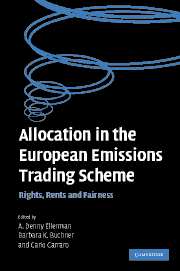Book contents
- Frontmatter
- Contents
- List of figures
- List of boxes
- List of tables
- List of contributors
- Introductory note/Foreword
- Acknowledgements
- Glossary and abbreviations
- Part I The EU ETS allocation process
- Part II Experiences from Member States in allocating allowances
- Part III Concluding remarks and background material
- Appendix I Participants
- Appendix II The individual country outlines
- Appendix III The country tables
- Appendix IV Background material from the European Commission
- Index
Appendix II - The individual country outlines
Published online by Cambridge University Press: 22 September 2009
- Frontmatter
- Contents
- List of figures
- List of boxes
- List of tables
- List of contributors
- Introductory note/Foreword
- Acknowledgements
- Glossary and abbreviations
- Part I The EU ETS allocation process
- Part II Experiences from Member States in allocating allowances
- Part III Concluding remarks and background material
- Appendix I Participants
- Appendix II The individual country outlines
- Appendix III The country tables
- Appendix IV Background material from the European Commission
- Index
Summary
Length: 7,000 to 10,000 words (about 21–30 pages with 1½ line spacing)
General: This Member State outline is intended as a means for providing unity in presentation to facilitate comparison while allowing room for individual authors to tailor their contributions to the story of their respective Member States. Accordingly, the section headings (Sections 1 to 6 below) should be respected, but authors should feel free to use subheadings within each section as appropriate, and as will probably be inevitable in Sections 4 and 5. The percentages in parentheses following each section heading are suggestions concerning the length of that section. In general, about half the paper should be devoted to an explanation of how the total quantity of allowances to be allocated was decided and distributed and the other half to aspects deserving emphasis for understanding the process in the particular Member State. Some sections will be more descriptive than analytical and each author will have to decide on the mix that serves best to tell the story of the particular Member State's experience in allocating carbon rights in an accessible and understandable manner.
Introductory background and context (10%)
This section should be used to inform the reader of important country-specific background and contextual features of the Member State that will help in understanding the allocation decisions that were made and the problems and issues that presented themselves in the process. Among these features, also the political capacity of each Member State should be tackled.
- Type
- Chapter
- Information
- Allocation in the European Emissions Trading SchemeRights, Rents and Fairness, pp. 378 - 380Publisher: Cambridge University PressPrint publication year: 2007

